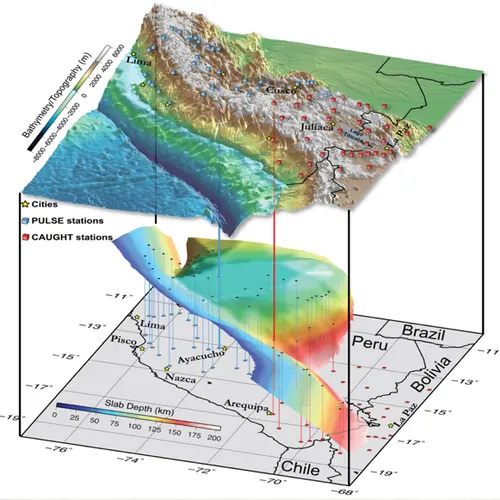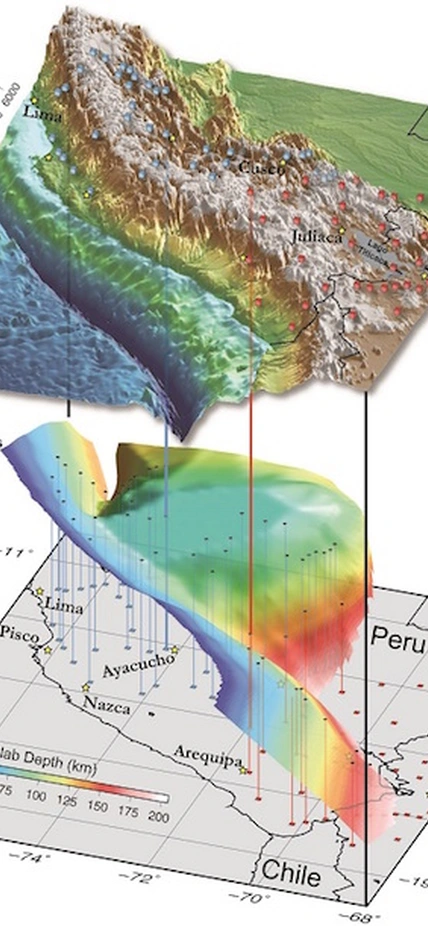Washington, DC— New work from an international team of researchers including Carnegie’s Lara Wagner improves our understanding of the geological activity that is thought to have formed the Rocky Mountains. It is published by Nature.
Subduction is a geological process that occurs at the boundary between two of the many plates that make up the Earth’s crust. An oceanic crustal plate sinks and slides under another plate—either oceanic or continental—and is plunged deep into Earth’s mantle.
Usually the lower plate slides down into the mantle at a fairly steep angle, sinking rapidly into the warmer, less-dense mantle material. However, in a process called “flat-slab” subduction, the lower plate moves nearly horizontally underneath the upper plate, sometimes for great distances.
Flat-slab subduction is used to explain volcanism and mountain formation that occurs far from plate boundaries, because the lower, “flat” slab moves inland beneath the surface of a landmass and thereby transmits the friction of the plates sliding against one another far inland. The formation of the Rocky Mountains between 55 and 80 million years ago, according to sedimentary and volcanic records that have been studied in detail since the 1970s, often is attributed to flat-slab subduction as the plate beneath the Pacific Ocean at that time slid beneath the North American continent.
Today, the largest flat slab is found beneath Peru, where the oceanic Nazca Plate is being subducted under the continental South American Plate. An undersea mountain belt, called the Nazca Ridge, sits on the Nazca Plate, and has been subducted along with the rest of the plate for the past 11 million years, according to previous studies
Although scientists knew that a flat slab existed in this region, much about how and when it was formed has remained a mystery. Using an array of seismometers placed over the region of flat-slab subduction, the team was able to image the structure of the subducted plate in unprecedented detail. This allowed the team to study the evolution of the Peruvian flat slab over time and to better understand the forces that created and sustain it.
What they found is that the angle of subduction is shallowest where the Nazca Ridge is being subducted beneath Peru. The portion of the plate containing this ridge sinks about 90 kilometers (56 miles) down and then flattens out. Away from the ridge, older portions of the flat slab that are no longer supported by the thick crust of the Nazca Ridge are found to be sagging, and younger, more recently subducted oceanic crust has torn free of the old, flat slab and is subducting at a normal dip angle.
“This was surprising as we expected to image large, older flat slab to the north. Instead, we found that the flat slab north of the subducting Nazca Ridge tears and reinitiates normal, steep subduction,” said lead author Sanja Knezevic Antonijevic, a student at the College of Arts and Sciences at the University of North Carolina at Chapel Hill.
Suction and trench retreat previously were theorized to be sufficient to create a flat slab. Suction is created between the upper plate and the downgoing slab, because the surrounding mantle is too viscous to creep into the narrow space between the two plates. Trench retreat occurs when the subducting oceanic plate moves dominantly downward, not laterally forward, resulting in an oceanward migration of the continent and trench.
However the team’s model shows that the subduction of the ridge is necessary for the flat slab’s formation, presumably because the buoyancy of the volcanically thickened Nazca Ridge keeps this portion of the plate from plunging steeply into the mantle. What’s more, removing the ridge from the model causes the flat slab to become unstable.
“Our model provides insights into the way that the Peruvian flat slab formed and evolved over time that can be applied to the studies of other flat-slab subduction events, such as the one that formed the Rocky Mountains,” Wagner said.
The other team members were: Abhash Kumar, also a student in the College of Arts and Sciences at the University of North Carolina at Chapel Hill; Susan Beck and George Zandt of University of Arizona; Maureen Long of Yale University; and Hernando Tavera and Cristobal Condori of Instituto Geofisico del Peru.

Caption: The revised geometry of the downgoing Nazca plate beneath the Andean mountains in southern Peru and northern Bolivia. Seismic stations are shown as colored cubes. Vertical lines show the location of these stations projected onto the slab. Image is provided courtesy of Lara Wagner.
_____
This work was supported by the NSF.
